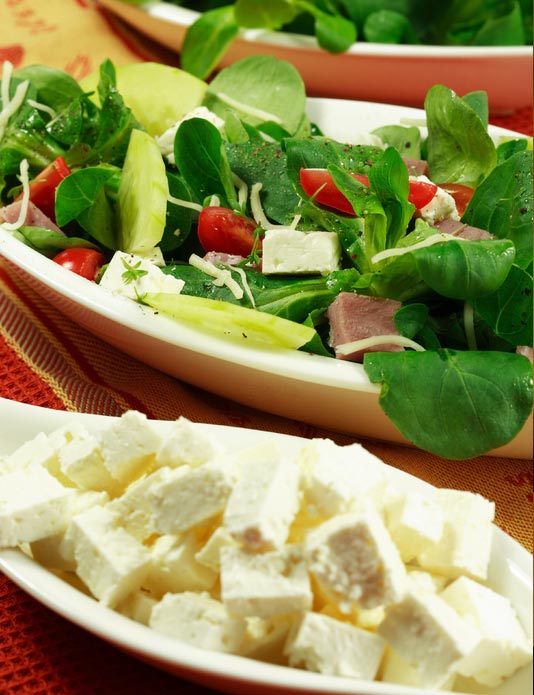
Eating healthy foods is one of the basic tools of diabetes care. Eating right helps keep blood sugar under control, and that protects you from the long-term health problems that diabetes can cause.
Food Groups
| Group | Serving per day |
|---|---|
| Bread, Cereal, Rice, Dry Beans, and Pasta | 6-11 |
| Vegetable | 3-5 |
| Fruit | 2-4 |
| Milk, Yogurt, and Cheese | 2-3 |
| Meat, Poultry, Fish, Eggs, and Nuts | 2-3 |
| Fats, Oils and Sweets | use sparingly |
When choosing foods from these groups, remember: usually, the closer to nature a food is, the better it is for you!
Eat a variety of foods.If you vary the foods you eat, you will have a better chance of getting all the vitamins and minerals you need. This means you should eat from all the food groups every day AND choose different foods. For best blood sugar control, keep the amounts that you eat from the Bread, Cereal, Rice, and Pasta Group, the Fruit Group, and the Milk Group about the same from day to day. These are the high carbohydrate foods that have the most effect on your blood sugar. They are high in nutrition and important to eat, but keeping amounts about the same from day to day will make diabetes control easier.The more processed a food is, the less it benefits you. Before you buy or eat a food, ask yourself, “Is there a better choice?”
| So-So Choice (Highly Processed) |
Better Choice (Less Processed) |
Best Choice (Closest to Nature) |
|---|---|---|
| Fruit “leather” and fruit drinks | Unsweetened fruit juice | Whole fresh fruit |
| Granola bar | Packet of instant oatmeal | Cooked whole oats |
| Canned vegetables (salty) Frozen vegetables with sauce (high fat) |
Fresh vegetables, raw or steamed | |
| Frozen yogurt with syrupy fruit topping | Fruit flavored yogurt | Plain yogurt with fresh fruit |
Maintain A Healthy Weight
Staying at a healthy weight is important for all people with diabetes. Extra body fat makes it harder for people with type II diabetes to make and use their own insulin. For these people, losing some extra pounds can be a powerful tool for diabetes control, especially in the first few years after their diabetes is diagnosed. People with type I diabetes may have trouble keeping their weight up to a high enough level if their blood sugars are too high.
Choose A Diet Low In Fat, Saturated Fat, And Cholesterol
Pure fats like oil, margarine, and butter give you very few vitamins and minerals. For best health, they should be only a small part of your overall nutrition. Fats that are solid at room temperature (animal fats and shortening, for example) should be a very small part of your diet because they are bad for the health of your heart.
Choose a diet with plenty of vegetables, fruits, and grain products.
By choosing the high carbohydrate plant foods you can increase your intake of important vitamins and minerals as well as fiber. Certain fiber may help lower blood fats, promote regular bowel movements, and slow the absorption of sugars after a meal. To get the most fiber in your diet:
- eat fresh fruits and vegetables
- eat the skins and peelings, if edible
- choose whole grain breads and cereals
- at at least one meatless main dish that includes dried beans, peas, or lentils each week
Remember, that starches, fruit, and milk raise blood sugar. The amounts of these foods you eat each day must be kept in balance with your insulin supply. This is true whether you rely on your own insulin or whether you take insulin shots.
Use Sugar In Moderation
High sugar foods, like desserts and regular soft drinks, give you very little nutritional value. For best health, they should be only a small part of your overall food intake.
Use Salt And Sodium In Moderation
Most Americans eat more salt than they really need. For some people, extra salt adds to their risk for high blood pressure. High blood pressure is more common in people with diabetes. And uncontrolled high blood pressure greatly increases the risk for many health problems related to diabetes. To make sure you do not get too much salt:
- use little or no salt at the table or in cooking
- avoid foods canned, boxed or frozen with extra salt
- use herbs, spices and salt-free seasoning mixes instead of salt
- use black, white or red pepper to season food
- remember to choose food “close to nature”. Less processed foods have less salt.
What About Alcohol?
If you drink alcohol, keep your intake “moderate”, and include it in your meal plan as extra calories. Here is a rule of thumb for what constitutes “moderate” alcohol intake:
- drink a day or less for women and small men
- drinks a day or less for men and large women
Twelve ounces of beer, 5 ounces of wine, or 1 1/2 ounces of hard liquor count as one drink. It is best to choose lower calorie drinks, such as lite beers and white wines.
Planning your Meals
Eating healthy foods is one of the basic tools of diabetes care. [...]
Gestational Diabetes
Thriftway Pharmacy Gestational Diabetes Gestational diabetes mellitus (GDM) is a [...]
Traveling with diabetes
Are you going on vacation? ... taking a business trip? ... visiting [...]
Caring for your feet
It is important to take special care of your feet when you [...]
Exercising with diabetes
Exercise is good for everyone. But it can be especially good for [...]
Diabetes Center
If you have diabetes, you know that it can cause serious problems, [...]







